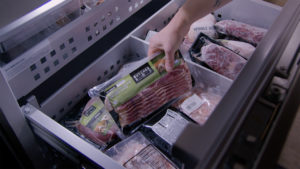Last Updated on January 27, 2025
One of the best perks of being a ButcherBox member is having a freezer full of high-quality meat and seafood right at your fingertips.
However, we understand that unpacking your box on delivery day can feel overwhelming, so that’s why we put together this guide sharing all our best tips and tricks to help you store, defrost, and cook everything in your box!
Getting Started: Delivery Day
Prep your freezer! Once you get word that your box is on its way, it’s time to make room in your freezer. As you unpack, we’ve found the best step to take when you receive your ButcherBox is to first figure out which cuts you want to cook within the next five days. Those cuts can go straight into your refrigerator to start defrosting. Everything else can go into your freezer where it can remain, frozen, for more than a year. (In theory, you can keep frozen meat indefinitely, however, for quality purposes, the USDA has some guidelines that you can find here on how long you should keep it frozen.)
To organize your freezer, start by putting bagged items on the bottom (think chicken nuggets, salmon, meatballs and shrimp), then and add individually packaged items (like chicken breasts and thighs) on top (pro tip: cut the packages so you can easily stack!), then any items like ground beef and ground pork can easily stack on top of one another to take up less space.

Now, let’s dive into defrosting.
Defrosting Option #1: The Fridge
The safest way to thaw frozen meat and seafood is in the refrigerator. An average size cut of meat, say like a filet mignon, chicken breast, or pork chop, takes a day to fully defrost in a fridge. Larger cuts, like a roast rib, pork butt, or whole chicken, take about 24 hours per four pounds to thaw.
When defrosting meat and seafood in the refrigerator, make sure to put the frozen protein on a dish, in a bowl, or a large, sealable bag. Sometimes, the frozen packaging gets small tears due to being jostled during shipping and while this does not affect the flavor, quality, or safety of the meat, you may have excess liquid leak as it defrosts.
Defrosting Beef, Chicken and Pork:
The night before you intend to cook it, place your chosen protein on a dish, in a bowl, or sealable bag in the refrigerator to defrost. Remember, be sure to keep your protein in its original packaging. It should be ready by the next evening!
Roasts may take a bit longer, so be sure to pay attention to the size of the cut when planning.
Defrosting Seafood:
Remove seafood from packaging and place on a plate or within a bowl and back in the refrigerator to defrost. Unlike beef, chicken, and pork, you want to remove the seafood from its original packaging.
Defrosting Option #2: Cold Water Bath
In a pinch? You can always defrost meat and seafood quickly by putting it in cold water — which can remain running or which you change out every 30 minutes. However, you should make sure that the packaging is sealed tightly; if not, you can put the meat in a sealed plastic bag to defrost in the cold water.
This method requires your undivided attention. Meat and seafood should never be left in the sink indefinitely as the risk increased for the meat getting to the “danger zone” (between 40 and 104 degrees F) where the risk for bacteria and food poisoning is high.
A one-pound cut of meat can defrost within an hour by using this cold-water method.
Did you know? Many of our products are ready to cook from frozen (think salmon burgers, beef burgers, chicken nuggets & strips, and meatballs) or are already cooked and just need to be heated before serving (think pot roast, cooked diced chicken, beef barbacoa and more). Check each package for the appropriate cooking time and save yourself the hassle of defrosting!
How Not to Defrost
It is not recommended that you defrost meat with hot water. Using hot water could bring the meat to the “danger zone”. If you are in a pinch, you can defrost with cold running water, as mentioned above, or cook from frozen.
Cooking from Frozen
Forget to defrost something? Good news, so many of our popular cuts can be cooked from frozen without compromising on taste.
Ground beef can be easily cooked from frozen on the stovetop by placing the frozen ground beef in the skillet, searing for four minutes, flipping the block and scrape the cooked beef off with tongs or a wooden spoon, and continuing the process until the ground beef is small enough to chop into pieces.
Steaks can easily be cooked from frozen in the air-fryer, just remember to use 50% more seasoning than you would if you were to sear or grill the steak!
Tossing frozen chicken (breasts or thighs!) in the InstantPot with a liquid like chicken broth or water and some seasoning is super simple and flavorful.
Salmon cooked from frozen is great in the oven and can yield some truly delicious results. Serve it coated in a delicious sauce alongside fresh veggies, or perhaps flaked over rice or noodles.
Now, let’s cover how to store your products once defrosted.
Storing Your Proteins in the Fridge (and how Long They Last!):
Now that your proteins are defrosted, here’s everything you need to know about storing them in the fridge as recommended by USDA.
Chicken: Due to our vacuum-seal packaging, ButcherBox chicken can last between 3 to 5 days in the refrigerator. (If the vacuum seal is broken, stick to the standard 1-2 day recommendation for poultry.)
Beef: When it comes to steaks or roasts, if the original packaging is sealed tight, it can remain in the refrigerator for almost two weeks. However, outside of its packaging or if the packaging is torn, beef is good for 3-5 days once defrosted in the refrigerator. Ground beef is a little different and stays fresh for 1-2 days in the refrigerator.
Pork: Most larger pork cuts — roasts, pork butt — come in stronger, vacuum-sealed packages and will remain good for up to two weeks once defrosted in the refrigerator.
Smaller cuts of pork that are in individual cut packaging will remain fresh for 3-5 days if it remains vacuum-sealed or 1-2 days if removed it from its original packaging.
Once you defrost bacon, it will remain good for 7 days in the refrigerator.
Seafood: Once defrosted in the refrigerator, seafood will be fresh for an additional one to two days.
Let’s Get Cooking!
Now that your box has arrived and you’ve arranged your freezer and refrigerator, it’s time to get cooking!
Our chef in residence, Ashley Lonsdale, has a simple meal prep formula for those busy nights and weeks. Her formula for meal preparedness is as follows: fresh + frozen + pantry + big flavor. Purchase a couple of ingredients in each category, and you should be able to quickly pull to. If you’re planning in more advance, think about stocking your kitchen with the right mix of ingredients in each of the formula categories so that you can always be ready to whip up a quick, nutritious meal. Check out Chef Ashley’s full Meal Preparedness Formula to become a master.
Got more time on your hands? Here are some of our favorite go to recipes.
Quick & Easy Baked Chicken Tenders
Classic Diner Patty Melts with Caramalized Onions
Pork Chops with Apples, Sour Cream, and Scallions
The ButcherBox Kitchen Team works hard to give you confidence you need to pull off any kitchen endeavor.



